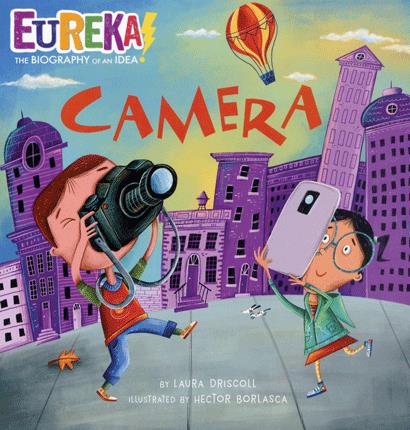| Camera (Eureka!: The Biography Of An Idea) Author: Driscoll, Laura | ||
| Price: $14.99 | ||
Summary:
A nonfiction "biography" of the camera, an everyday object that has become ubiquitous, starting with its origins with the discovery of certain properties of light and up through the development of the digital camera.
| Illustrator: | Borlasca, Hector |
Reviews:
School Library Journal (08/01/21)
Full Text Reviews:
Booklist - 04/15/2021 The appealing Eureka! The Biography of an Idea series (4 titles) introduces primary-grade students to the history behind familiar inventions, from an initial concept or prototype to versions familiar to users today. The writing is simple, clear, and often lively. Richly colorful, digital artwork suggests the look of different time periods and cultures, while portraying individuals who developed each invention and showing how its appearance has changed through the years. Labeled diagrams illustrate how the technologies described actually work. Beginning with the first written records of a camera obscura in ancient China, Camera notes the ever-increasing sophistication and portability of related devices invented worldwide. Well attuned to the intended audience, this series is both engaging and informative. - Copyright 2021 Booklist.
School Library Journal - 08/01/2021 K-Gr 3—Veteran children's author Driscoll offers a broad history of using light to take pictures: "Photos are all around us. Cameras, too. How exactly did people figure out how to freeze time this way?" This simple overview covers 2,500 years of photography. Colorful, cartoon illustrations fill each spread providing useful visual explanations. The history begins with a tiny hole in a wall that evolved into a camera obscura until lenses and a means to capture images via tar, glass plates, and, eventually, film came into practice. The time line is interrupted midway with a center spread that depicts a boy using a single-lens reflex camera diagrammed to represent the path of light. The focus then switches to different types of cameras with recording light on pixels rather than film described as the 1980s breakthrough that created digital cameras. The basic concept of stopping a moment in time is still the result regardless of how an image is recorded. Quick facts and tips for taking good photos are included. VERDICT For collections where there is an interest in photography.—Janet S. Thompson, Chicago P.L. - Copyright 2021 Publishers Weekly, Library Journal and/or School Library Journal used with permission.



